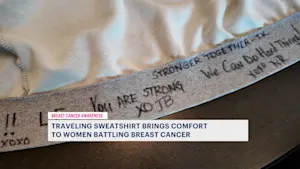More Stories
Many women underestimate breast density as a risk factor for breast cancer, a study shows.
Women with dense breast tissue are up to four times more likely to get breast cancer, according a study published in the JAMA Network Open.
Dense breasts are normal and found in about half of women undergoing mammograms, however, the extra glandular and fibrous tissue can make tumors more difficult to see on mammograms.
For the study, researchers surveyed just under 2,000 women between the ages of 40 and 76. They found that about 93% of women did not view having dense breasts as a significant risk factor for getting breast cancer, especially when compared to other more well-known risks, like having a first-degree relative with breast cancer.
One breast cancer doctor said the study shows there needs to be more education about the link between dense breasts and breast cancer for women and health care providers ordering mammograms.
HOW DO YOU KNOW IF YOU HAVE DENSE BREASTS?
A mammogram shows how dense your breasts are. When you get the results of your mammogram, you may also be told if your breasts have low or high density.
WHAT ARE THE PARTS OF THE BREAST?
A woman’s breast has three kinds of tissue:
Fibrous tissue holds the breast tissue in place.
Glandular tissue is the part of the breast that makes milk, called the lobes. The tubes that carry milk to the nipple are called ducts. Together, fibrous and glandular tissue are called fibroglandular tissue.
Fatty tissue fills the space between the fibrous tissue, lobes, and ducts. It gives the breasts their size and shape.
WHAT IS BREAST DENSITY?
Breast density reflects the amount of fibrous and glandular tissue in a woman’s breasts compared with the amount of fatty tissue in the breasts, as seen on a mammogram.
WHY IS BREAST DENSITY IMPORTANT?
Breast cancer risk: Women with dense breasts have a higher chance of getting breast cancer. The more dense your breasts are, the higher your risk. Scientists don’t know for sure why this is true. Breast cancer patients who have dense breasts are not more likely to die from breast cancer than patients with non-dense (fatty) breasts.
Dense tissue can hide cancers. Fibrous and glandular tissue looks white on a mammogram. So does a possible tumor. Because it’s hard to tell the difference between a tumor and dense breast tissue on a mammogram, a small tumor may be missed.
 The image on the left shows a mostly fatty breast, and the image on the right shows a dense breast.
The image on the left shows a mostly fatty breast, and the image on the right shows a dense breast.
WHO IS MORE LIKELY TO HAVE DENSE BREASTS?
The density of your breasts can change over time. Generally, you’re more likely to have dense breasts if you:
Are younger.
Are pregnant or breastfeeding.
Are taking hormone replacement therapy.
Have a lower body weight.
SELF-EXAM: 11 steps to check for breast cancer
WHAT SHOULD I DO IF I HAVE DENSE BREASTS?
Talk to your doctor about your personal risk of getting breast cancer. Dense breasts are just one of several risk factors for breast cancer. Your doctor will also think about other factors, like your age and family history of cancer.
Different tests may be able to find some cancers that are missed on a mammogram. But these tests are more likely to have a false positive result (the test is reported as abnormal, but you really don’t have cancer). False positive test results often lead to unnecessary tests, like a biopsy. Also, you may have to pay for these tests.
Your doctor may suggest one of these tests:
Breast ultrasound -- A machine that uses sound waves to make pictures, called sonograms, of areas inside the breast.
Breast magnetic resonance imaging (MRI) -- A kind of body scan that uses a magnet linked to a computer. The MRI scan makes detailed pictures of areas inside the breast.
Talk with your doctor about how often you should be screened for breast cancer and which tests your doctor recommends.
More from News 12
1:32

beWell: Proactive and empowering breast cancer awareness info
2:12

A hoodie and hope: New Jersey women share sweatshirt to bring comfort during breast cancer treatment
2:30

DiCuore Diamonds founder Daniela Sokolowski's breast cancer survival story
1:47

Thousands ‘Make Strides’ on Coney Island boardwalk for breast cancer research
4:45

Actress brings real-life experience with BRCA gene, genetic testing to 'Love Danielle'
2:52
